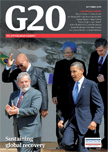

 |
 |
|

Bretton Woods 1944 versus Pittsburgh 2009
By Naoki Tanaka, president, Centre for International Public Policy Studies
[Japanese version]
To download a low-resolution pdf, click here. (Be patient! It's 7.7 MB.)
With previous summits focused on rebuilding the financial architecture, G20 leaders are unlikely to achieve as much as their counterparts did 65 years ago
The next summit of the G20 countries and regions — the third — takes place in Pittsburgh on 24-25 September 2009. When world leaders gathered at the two previous summits, they shared a common objective of stabilising economic management by rebuilding the international framework. However, the third summit will likely see participants come with expectations that have diverged considerably from those before. Already, G20 members have taken different directions to tackle the immediate problems, with an architecture for those yet to emerge. The G20 has moved away from its crisis-solving role; it is now trying to grapple, step by step, with creating a framework to address the factors underlying the crisis on a stabilised and sustainable basis.
Yet at Pittsburgh, the G20 is unlikely to attain something like a new Bretton Woods system, which provided the post-World War Two international economic framework. Three causes explain why excess expectations of this summit should be curbed.
First, regrets over past misdeeds that caused major human-made confusion and calamity have yet to converge on one central point. The predominant view now attributes the Great Depression to failed monetary policy.
But Cordell Hull, the US secretary of state who hosted the Bretton Woods Conference in 1944, could not abandon the view that the protectionist policy adopted by Washington triggered a chain reaction of global economic contractions. The widening gap between supply and demand in US industry, as in the steel sector, spawned a political argument that imports should be shut off from American markets by higher tariffs, leading to the passage of the 1930 Smoot-Hawley Tariff Act.
This became a precursor to a movement to form a protectionist trade bloc among countries of the British Commonwealth. Many thought that such unchecked protectionism, which held sway from 1929 to 1932, was the underlying cause of the subsequent breakout of World War Two. This analysis inspired Hull to take the initiative in building an architecture for the postwar international economy at Bretton Woods.
It is now obvious that today’s credit crunches are directly attributable to the creation and sale of subprime loans and the introduction and marketing of synthetic financial products, such as collateralised debt obligations. Neither monetary nor trade policy thus provides the unifying catalyst today.
Modifying financial services
But have views converged on this point? The offering of extremely high executive pay has clearly disappeared among American financial services industries. Until only a few years ago, it was not unusual for top-class executives to demand $10 million in annual remuneration. But now they would prefer to be on the frontline of work even at $200,000. Of course, their pay packages include a contingency fee incentive, but many such executives say they are happy with a fee that is one tenth or even one fiftieth of what they used to receive.
Pundits have failed to reach consensus about the cause of the credit crunch because it is difficult, through financial activity, to control the risks that may arise in the future. If finance is defined as nothing more than intermediary activity between the demand for funds and the supply of those funds, it is easy to consider controlling such financial activity from the viewpoint of avoiding systemic risk. International agreement is possible over time.
At the Bank for International Settlements, members’ monetary authorities have tackled reaching agreements and their revisions for more than 20 years. Discussions have focused on measuring the sufficiency of banks’ equity capital for absorbing shocks from impaired capital and replenishing such capital to adequate levels. The G20 can readily reach a new agreement by extending this line of thinking.
However, it will not be easy to build consensus if financial activity is defined as distributing resources to link the present to the future. The key to such resource distribution lies in devising methods for diversifying and controlling risk. Banks’ credit extension and selling of loan claims have thus far been considered indispensable for risk diversification. Hence the birth of the credit market for trading loan claims should be regarded as a sign of progress in financial activity.
In light of the importance of corporate rebuilding, debtor-in-possession (DIP) finance — which means financing arranged by a company during the bankruptcy process – would also show progress. In bailing out a company from the abyss of bankruptcy, it is desirable that the subject – one who responds to a request for financing after evaluating the risk involved in the failing company’s core operations – emerges from among those familiar with the relevant industrial sector and the operations of individual companies therein.
Should a uniform regulatory net thus be cast on the credit market and DIP finance? Most market participants would probably reply that the current mechanism should remain rather than face new regulations, as that would improve the efficiency of the economy. The implication is that the G20’s intervention should not go as far as such risk-hedging methods. Arguments may be raised over the pros and cons of demanding information disclosure by hedge funds and applying uniform regulations to credit rating agencies. But these are not issues of a scale that will lead to a new financial architecture.
Stage setter
The second factor that divides the G20’s current endeavours from the Bretton Woods system is that the world now lacks a stage-setter country with the calibre of the United States in 1944. The US now is saddled with the long-term task of adjusting household debt levels, which enables it to play only a limited role in lifting world economic demand. The US is far from the overpowering presence it enjoyed in the aftermath of World War Two.
While some see China and India as substitutes, both are struggling with many domestic contradictions. The pressing issue is thus how to position China and India in the existing global economic order. They are probably objects, not subjects.
The third difference from the Bretton Woods environment is that today’s ongoing crisis demands upholding the improvement of the quality of economic activity. Countries must now confront the severity of climate change and other environmental issues.
At Bretton Woods, participants peacefully and tacitly approved of emerging countries raising their share of the world markets. Bretton Woods organisers were aware that an underlying cause of the war had been the exclusion from world markets of rising powers such as Japan and Germany. Proposals were made to smoothly integrate emerging countries into the world economy, by ensuring free trade, nondiscriminatory treatment and a free payments system.
In contrast, there is little room today to allow rising countries to engage in free-wheeling economic activity that could have an irreversible adverse impact. These emerging economies cannot build from within an environmentally friendly economy through a shift in their industrial paradigm, as spending on research and development constitutes only a limited percentage of the cash flow they generate.
For the next while, the world has no choice but to continue taking cosmetic measures to solve, one by one, the biggest contradictions that exist in today’s compound international economic system.
|
This Information System is provided by the University of Toronto Library |
All contents copyright © 2023. University of Toronto unless otherwise stated. All rights reserved.